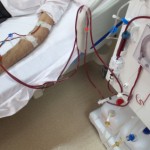It's been a long time since I've written about Hantavirus, but I recently saw mouse droppings in our basement storage area and that brought me back to the topic. My first knowledge of this organism came from an episode of "MASH" where Hawkeye encountered a patient with a low platelet count and acute kidney failure and had to send the man to a dialysis unit in Tokyo. I got interested in the disease that soldier contracted and, since I was on Active Duty at the time, put it in my "War File." Years later I found articles showing exposure to the virus of longshoremen in a number of US ports and then in 1993, five young, previously healthy victims who lived in the Four Corners region, where Arizona, New Mexico, Utah and Colorado meet, died of a new manifestation of this virus.
There's a thorough paper on Hantavirus available online from the Center for Food Security & Public Health at Iowa State's College of Veterinary Medicine. The disease comes in two forms: the kind I first became aware of is hemorrhagic fever with renal syndrome (HFRS) and the newer variety is hantavirus pulmonary syndrome (HPS). There are huge differences between the two types.
Let's start with HFRS. The CDC's description of this "syndrome" (the term syndrome is normally used to describe a cluster of symptoms that together are characteristic of a disease) calls it a group of clinically similar illnesses. A number of different rodents and shrews (small, insect-eating, pointy-nosed mammals) carry the virus and four of the twenty hantavirsus subtypes identified are most frequently associated with HFRS in various countries/regions.
HFRS starts abruptly with fever, chills, headache, backache and exhaustion as the most common manifestations. After a few days to a week, severe cases develop hemorrhagic (bleeding) complications and kidney involvement with some going on to shock, kidney failure and death. Intensive nursing care, dialysis and an anti-viral medication called ribavirin are used to support the patients who have this dire form of HFRS.
The fatality rate varies considerably depending on which virus subtype is involved. For one particular hantavirus, found mostly in Europe, less than 1% of those affected may die; for the form I was first familiar with, caused by the Hantaan virus, 5 to 15% of patents will die.
Worldwide, up to 200,000 people are hospitalized with HFRS every year. Most of those cases occur in Asia (with much smaller numbers in Europe); up to 8% of the population there have antibodies indicating past infection with some form of the Hantavirus.
Other animals, including cats, dogs, pigs, horses and even moose may have antibodies to the virus, but don't appear to get sick from it.
Better than treating the disease, of course, is preventing it. Making your home or other buildings mouse-proof isn't easy, but storing food in secure containers and using traps and rodent poisons may go a long ways toward avoiding the disease. The CDC website has detailed instructions on safe ways to clean up rodent droppings and urine. CDC warns you should never start by sweeping or vacuuming!
Now I need to clean up the mouse debris in our furnace room.



